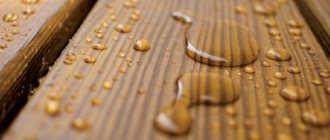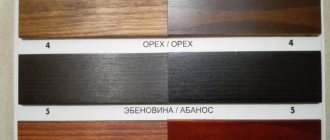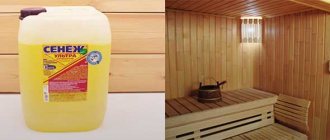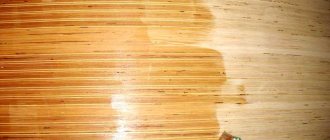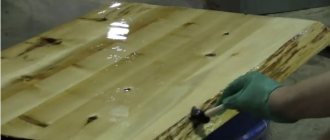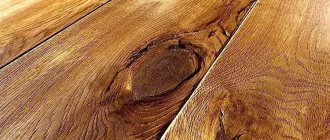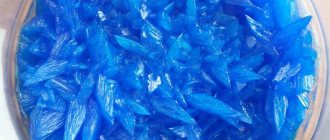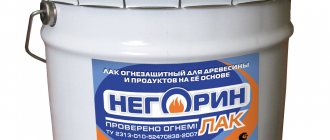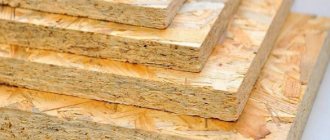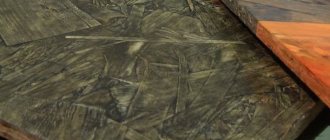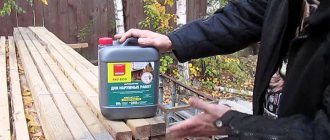Updated: 03/12/2021 15:14:28
Expert: Andrey Nikolaevich Kuznetsov
*Review of the best according to the editors of expertology.ru. About the selection criteria. This material is subjective in nature, does not constitute advertising and does not serve as a purchase guide. Before purchasing, consultation with a specialist is required.
Wood is a popular building material that is widely used in Russia. To increase the lifespan of wood, it must be carefully cared for. Special impregnations help protect wooden structures from negative atmospheric influences, rotting, the appearance of fungus, mold and insects. In addition, some compositions reduce the flammability of the material, making it fireproof. The domestic market offers products from different manufacturers, each of them praises its own antiseptic. Advice from our experts will help you avoid making mistakes when choosing a composition.
Why do you need moisture impregnation for wood?
Being a natural material, wood is naturally hygroscopic and tends to absorb moisture upon contact with melt water and precipitation. When wood humidity increases by more than 15%, it begins to swell, delaminate, and lose its shape. Over time, mold and fungi appear on it, and rotting processes develop, which reduce the durability and aesthetics of wooden structures.
Modern moisture impregnation for wood gives products water-repellent properties and helps to avoid high humidity. Its use minimizes the risk of rot, which not only spoils the appearance of the tree, but also negatively affects human health. Spores of putrefactive formations can enter the human lungs and provoke chronic diseases, so protecting wood from excessive humidity is an important step in creating a favorable microclimate in the house.
Types of impregnations
Water-repellent substances for wood rarely contain additional components that impart protective properties to the material. It all depends on the use of impregnations, so they come in different types:
- Fireproof impregnations. They are distinguished by their ability to not support combustion at high temperatures, where unimpregnated material would have ignited long ago. The spread of fire is reduced to a minimum. In addition to being anti-flammable, this composition protects the wood from the penetration of parasites and mold, and does not allow pests to multiply inside. You can use such substances without any restrictions, as they are completely safe for the environment. The peculiarity is that the products must be applied regularly, over a period of four to six years.
- Protective liquids against mold and rot are most often used to preserve houses, impregnate facades, wooden panels, lining, and fiberboard. The substance has increased water-repellent capabilities and is used everywhere. Thanks to the colorless composition, there is no need to worry about the preservation of the aesthetic qualities of the structure.
- Tinting agents. In addition to moisture reflectors, they contain dyes. After application, the wood is not only processed, but also acquires color.
Reasons for accelerated destruction of wood
Trees growing in nature have reliable protection in the form of their own tree bark. During the construction of buildings or the manufacture of various wood products, the bark is removed, which entails a violation of the wood structure under the negative influence of the external environment. If structures do not have wood impregnation against moisture and rot, they will collapse due to the following factors:
- Fungi and mold - often affect wood in conditions of humidity and limited air access. Wood serves as an excellent breeding ground for harmful microorganisms, especially if it is saturated with moisture.
- Insects - the most common enemies of wood are the weevil, bark beetle, wood borer, which can not only harm the wood, but also completely destroy it. Characteristic signs of insects are small holes and grooves visible on the wooden surface.
- Moisture - rain, fog, melting snow, and simply increased humidity indoors lead to swelling of the wood and the formation of cracks, and also favor the appearance of rot. Impregnation for wood against moisture reduces the water absorption of the material without affecting its ability to “breathe”.
As additional factors that negatively affect wood, it is worth mentioning ultraviolet rays, which destroy the natural substance lignin, which is responsible for the hardness and rigidity of wood. Under the influence of the sun, wooden products become softer, lose their natural color and become cracked.
| Buy wood impregnation |
| 8 (495) 995 40 39 |
How oil protects wood
In the understanding of most people who are encountering the intricacies of processing wooden building materials for the first time, the combination of the words “oil” and “wood” has nothing to do with the concept of “protection.”
Quite the contrary - it is assumed that the clothes of anyone who touches it should be protected from an oiled surface, and impregnation of walls, floors and furniture with oil looks, to put it mildly, unnatural.
Let us explain how this effect is used to protect log or timber houses.
As is known, the main enemy of construction wood is seasonal changes in internal humidity, which are the main cause of mechanical deformations and the development of microbiological diseases of the tree trunk.
The main channel for moisture penetration into the log is the capillary network, caused by the porous structure of the wood. Oil impregnation reduces the throughput of this network several times, while maintaining the effect of vapor permeability.
The depth of oil penetration depends on the processing method and in some cases can reach 15 mm in cross section. The outer layer of impregnation, upon contact with UV rays and air, turns into a completely inert film, its properties identical to the varnish coating.
It is believed that the deeper the oil penetrates, the more effective the protection created. In this connection, the most effective methods of impregnation are considered to be long-term boiling in oil or vacuum saturation of wood with a protective composition.
It should be noted that the purpose of such treatment is not complete polymerization of the impregnation over the entire penetration depth. Despite the fact that after drying the treated board or log is completely inert on the outside, the oil in the inner layers can remain in a liquid state for many years.
An important factor that significantly influenced the explosive growth in the popularity of oil impregnations was the original decorative effect, emphasizing the internal structure of wood. As a result, oil protection today is considered not only as a technical measure, but also as an option for painting houses made of timber or logs.
To summarize what has been said, we list the main advantages of treating wood with oil:
- the tree's moisture level is stabilized (as a result, the seasonal deformation coefficient decreases);
- protection against microbiological damage is created;
- oil-soaked logs and boards are less attractive to wood-boring beetles;
- “for the same money” a beautiful aesthetic effect is created.
Among the disadvantages, it is worth mentioning the fact that oil protection is relatively short-lived. The interval between repeated treatments is about 2-5 years. But from a technological point of view, re-application of impregnation is an order of magnitude simpler than a similar operation for traditional paint and varnish coatings.
By place of application
Based on their localization of processing, impregnations are internal and external. The former are used for interior work and are environmentally friendly. They have a gentle effect on microorganisms and do not harm human health. External products are used for outdoor work and provide better protection for wood, but are more toxic.
By active component
The main active component in wood impregnations against the influence of moisture can be substances of organic and inorganic origin. Most often, compositions are made on an oil base, acrylate or alkyd resins, as well as on volatile chemical components that cannot penetrate deep into the wood, but form a durable protective film on its surface.
By solvent
Depending on the solvent for impregnation, mixtures can be aqueous or non-aqueous. In the first case, the active component is mixed with water, which provides the wood with good pore wettability. As for non-aqueous mixtures, they are diluted with alcohol or chemical solvents, which, when applied to the surface, quickly evaporate into the atmosphere.
If you need reliable impregnation for wood against moisture and rotting, you can select the necessary material in the TBM-Market store. Our catalog contains products for both external and internal work, allowing you to provide good protection for wood for many years.
How to properly treat the outside of a log house
For the first time, the log house is treated with antiseptics inside and outside immediately after assembly. Pay special attention to the treatment of the ends and logs in contact with the foundation. Antiseptics are applied in two layers; Primary treatment should not be carried out at temperatures below 10-12 degrees!; The next treatment is done after the log has completely dried and the frame has shrunk. This takes 6-12 months. This finishing involves the final complex and multi-layer processing of the house, which will provide protection for the log for a long time.
It is important to apply antiseptics to a dry and clean wood surface!; Before processing, the logs are sanded to remove the top layer in which fungus and microbes have accumulated during shrinkage. It will remove log defects and level the surface
Sanding wooden walls is a must for an old house, as it is important to completely remove the previous coating;
How to choose an effective moisture impregnation for wood?
In order for impregnation to give the maximum effect, it is recommended to familiarize yourself with the characteristics of the products offered and select exactly the material that best suits the specific type of wooden structures and their operating conditions. The main aspects to pay attention to include:
- depth of penetration of the product into the wood;
- environmental safety of wood impregnation against the negative effects of moisture, presence/absence of a pungent odor;
- place of application - for external or internal work;
- the degree of action of the composition on different types of fungus, mold and insects;
- material consumption - on average it should be up to 200–250 g/m²;
- validity period of the mixture.
When purchasing, you should take into account the climatic conditions of the area. If the house is located in areas with frequent precipitation, it is best to choose impregnations that effectively protect the wood during sudden temperature changes. For places with high humidity, it is advisable to take a water-repellent composition, the main function of which is to protect the wood from moisture.
Buy wood impregnation
|
|
Why do you need to impregnate wood?
A wooden bathhouse, a house, a gazebo, or some individual building structures are always subject to aggressive atmospheric influences. These are moisture, wind, sun, temperature fluctuations. Don't forget about insects. Sometimes the very active actions of small woodworms can lead to very disastrous results.
Protective equipment and tools
Whatever you say, the biggest enemy of a tree is water. It is the increased moisture that causes premature aging and destruction of wooden buildings. Simply put, the wood simply rots, mold and mildew do their insidious work. Modern water-repellent impregnations for wood can perfectly solve this pressing problem. Those impregnations that protect against water and moisture are usually called antiseptics. Antiseptics work well against mold, fungi and wood rot.
The second destructive problem is fire. Wooden structures also often become hostage to fire. Of course, there are no impregnations that would completely prevent wood from burning. But modern water-based components can significantly enhance the resistance of wood to high temperatures.
A simple example from life. Many people have probably paid attention to modern wooden electrical poles (poles for wires). Now they are greenish in color - treated with a special impregnation. If such supports (used) are used as firewood, then there can be no talk of any hot bath. Such firewood burns very poorly and to light it you will have to put in a lot of effort (tested from my own experience). Impregnations for wood of this type are called fire retardants, that is, they protect against fire.
Application of decorative impregnation
The sun, or rather its ultraviolet radiation, is also harmful to wood. Planks or other wooden structures exposed to the sun will turn gray and unattractive after 3-4 years. There is no longer any aesthetic appearance.
To get rid of this “gray” problem and maintain the presentable appearance of the structure, it is necessary to use impregnations containing so-called ultraviolet filters. Wood treated with such an antiseptic will retain its original beautiful appearance for a long time.
There are many different insects that are not averse to feasting on the tasty composition of wood. For example, ants really “love” slightly rotten wood and can destroy the lower crown of a building in a season. Bark beetle larvae gnaw entire tunnels inside wooden structures. This includes more than a dozen similar living creatures that love to feast on wood. Impregnations that contain insecticides that are harmful to insects are also used against such an enemy.
To summarize, we can say the following. Wood is treated primarily to protect it from rot, fungus, insects, fire, temperature changes and ultraviolet radiation. These are the main reasons for protecting the tree.
Rules for treating wood with moisture impregnation
As a rule, impregnation for wood against moisture and decay does not cause difficulties in application, however, when processing wood, you need to follow certain recommendations that will help you apply the composition correctly and guarantee its long-term action:
- Before processing, it is necessary to clean the wood from dust, grease or previously applied paints and varnishes.
- If traces of fungus are already visible on the wood, it needs to be treated with a brush with metal bristles.
- An integral step is thorough drying of the wood, since dry wood does not absorb moisture as intensively.
- Impregnation is applied with a brush or roller, starting from the sections of the board, its end elements and those parts of the wood that have already been damaged. When processing, you must wear personal protective equipment.
- If moisture impregnation for wood needs to be applied in several layers, then you should wait for each previous layer to dry.
Recommendations for selection
What should you follow to choose the right impregnation for the job? Before choosing, you need to answer the following questions:
- Do you only need a water-repellent substance or do you need additional features.
- Do you need to stain wood to give it a natural look?
- What volume do you need to select the amount of impregnation?
Thus, additional processing of wood with your own hands today has become mandatory for every home, as it has a whole set of positive qualities. Extending the life of wooden buildings, resisting fire, moisture and harmful substances is the merit of the modern generation in the construction market.
When is the use of impregnations especially necessary?
Since wood is subject to the greatest damage in conditions of high humidity, the use of antiseptics is especially important in areas where moisture has the maximum destructive effect. These include basements, baths and saunas, outdoor gazebos, garden furniture, as well as those parts of wooden structures that have close contact with the ground.
Treatment of such a surface can be carried out both at the construction stage and on finished structures. Using a wood stain to protect against moisture and rot, you can minimize the appearance of fungus and mold stains, avoid rot and protect wood materials from the destructive power of water.
Modern methods of combating wood rot
Protection from moisture using modern methods is carried out in two ways: the preservation process and treatment with antiseptics. With the method of preserving wood material, the process lasts quite a long time. During its course, the solution impregnates and etches the affected areas. In this case, the board is placed in a container with a solution and soaked for a certain time.
You can carry out diffusion or autoclave impregnation, which is carried out only in factory conditions.
Antiseptic impregnation involves a treatment that is performed by applying a special substance to wood. To do this, use a paint brush, roller or sprayer. Before soaking, the board is prepared. In accordance with the intended purpose, impregnation is used that is suitable for this function.
For example, white spirit is quite easily removed from the surface, so it is not recommended to use it in rooms where there is a high degree of humidity or dampness. The question arises - how to protect the wood in this case? Water-repellent products are best.
How to protect a tree with improvised means?
There are many available products that can easily replace store-bought solutions. Most often used to protect wood:
- silicate (carpentry) glue;
- a solution of soda and vinegar;
- resin;
- copper sulfate;
- used machine oil;
- sulfuric acid in combination with potassium dichromate;
- compositions of boric acid, water and salt.
These options are not as effective as impregnation for wood against moisture and rot, since they prevent the effects of moisture only for a short time. If you want to get a long-lasting and really high-quality effect, the optimal solution would be to contact the TBM-Market online store and purchase reliable wood impregnations from European manufacturers.
| Buy |
Types and types of modern wood antiseptics
Let's understand a little about the very concept of antiseptic. Often, it is popularly understood as a paint and varnish material that will protect wood from biological influences. But in fact, this is an impregnating primer, which impregnates the material with a special composition and is designed to give it additional properties.
This impregnation provides protection against blue stains, mold, mildew and small fans of grinding cellulose. And the deeper the impregnation penetrates into the wood, the more reliable protection it provides.
two main types of substances used in modern antiseptic preparations :
- oxidizing agents that destroy fungal cells.
- fungicides , as organic and inorganic compounds: salts of heavy metals, copper and phenol derivatives.
Unlike oxidizing agents, fungicides block fungal enzymes and prevent them from feeding, in a word, they make them starve. And all antiseptics have a liquid consistency. This is necessary so that it can penetrate as deeply as possible into the tree.
Colorlessness vs. tinting: which is more rational?
If you already treat the wood with an antiseptic, it will never be the same color as before. Therefore, why not purposefully paint the surface of the wood in the desired shade, which will be successfully combined with other interior or exterior items?
For example, the same manufacturer Tikkurila produces colorless biocidal antiseptics that are designed to penetrate deeply into wood. But they should be additionally protected with a water-thawing compound so that the antiseptic does not wash out over time.
In principle, if you just need processing, without subsequent painting, any antiseptic is suitable for you . After all, there are those after which the wood should not be coated with another word in the future - these are the ones that are used for impregnating sleepers or telegraph poles.
And in general, the very presence of an antiseptic often serves as a kind of problem for future paint. That’s why modern manufacturers offer a comprehensive option – a paint and varnish material that already has universal protection against microorganisms – biocides. Although, like any universal option, such solutions do not always give the best result, especially if the lumber brought is problematic.
As for the color itself, in order to preserve the natural shade of the wood, choose an azure coating. For example, something like this is produced by a well-known company and it’s called Illumina . This is a special azure coating that can be used both indoors and outdoors. It is colorless and only emphasizes the natural structure of the wood. But among the colorless ones, the “ Azure ” coating from Belinka .
But keep in mind that the color itself, in addition to the aesthetic component, also protects the wood from fading, and helps to more carefully cover the surface with an antiseptic composition, without missing a centimeter anywhere. Therefore, so that during the processing of wood you do not have any accidentally missed places, add fabric dye to the solution yourself: approximately 50 g per 100 liters of solution. Dilute the dye in a small amount of water and pour into the prepared solution.
Base: water based, acrylic or organic?
All modern antiseptics are divided into three main groups: water-based (water-soluble), based on impregnating oil (oily) and based on organic solvents (organic-soluble) . Water-soluble antiseptics include sodium fluoride and silicon, ammonium, copper pentachlorophenol, and so on. And for oily ones - coal antiseptic, creosote, anthracene and shale oil.
Also, based on their properties, they are classified into the group of non-washable, difficult to wash out and easy to wash out. Non-washable antiseptics include only oily antiseptics and those based on organic solvents, while all others are water-soluble compounds.
To achieve the desired effect in terms of penetration into wood, manufacturers mix antiseptic solutions based on alkyd, silicone and acrylic:
Solvent-based antiseptics form an elastic, water-resistant, but at the same time vapor-permeable film with good protective properties. Such antiseptics are great for those wooden surfaces that are subject to constant mechanical stress, such as stairs, railings and decking. And after applying such an antiseptic, they can then be coated with wear-resistant waterproof varnish.
Water-based antiseptics are acrylic-based products that are odorless and solvent-free. These are fire- and explosion-proof, can be applied to damp wood without problems and have excellent properties. The only point: their color becomes final after complete drying, and therefore designers do not like to tinker with them, because it is impossible to predict the exact result.
But silicone is considered a new generation antiseptic , which combines the best qualities of previous options. This antiseptic is made from silicon, and it does not burn and is not toxic in case of fire. Silicone does not decompose over time and is biologically neutral, and therefore this composition is used both for interior spaces and for wood outside.
A couple more important points. Silicone has excellent water-repellent properties, but at the same time it “breathes”, is elastic and stretches and contracts with wood, without cracking, unlike its analogues. At the same time, the particles in silicone impregnation are small and penetrate deeply, protecting the wood from the inside. It also dries quickly, in just 2 hours, because its vapor permeability is higher than that of acrylic and alkyd-based antiseptics. Thanks to this it lasts twice as long.
Application method: dipping or spraying
Antiseptics are also divided according to the method of application. For example, most often we are talking about only two main methods: superficial, for which you need brushes or a hydraulic remote control, and deep, when the wood is completely immersed in a hot or cold solution.
Here, a lot depends on what type of wood will be processed and what part of it. For example, ripe firewood and coniferous wood are always poorly saturated with antiseptics under normal conditions, but great when heated to 95° and 100°C:
Dry wood is best impregnated with organic or aqueous liquids, but some solutions will be distributed in it with great difficulty, spreading and lingering on the surface zone in the form of salt.
But if the wood is kept raw, it can be easily impregnated with water-soluble antiseptics. These react with internal wood moisture. Thus, the sapwood of pine, beech and birch are most easily impregnated.
